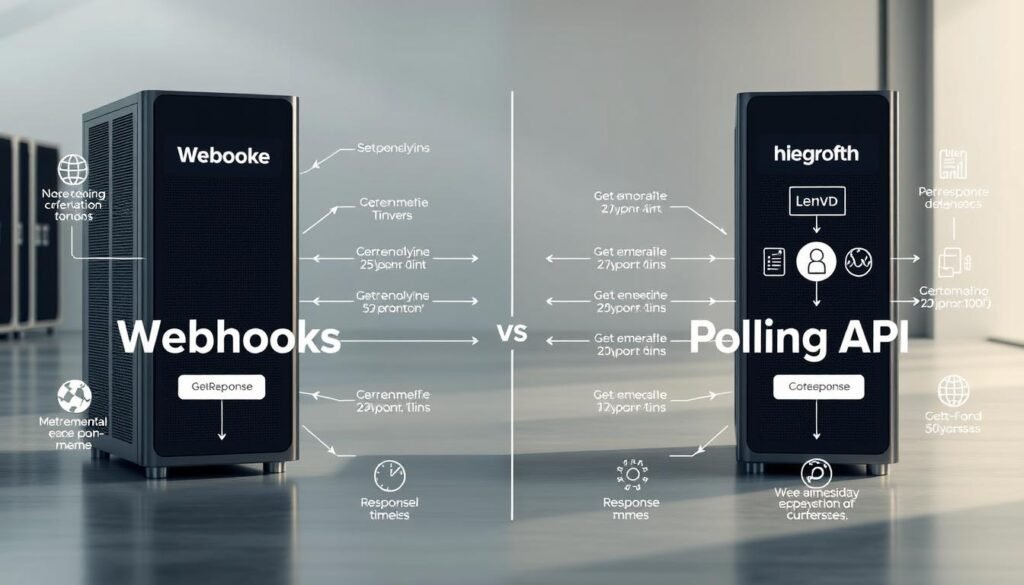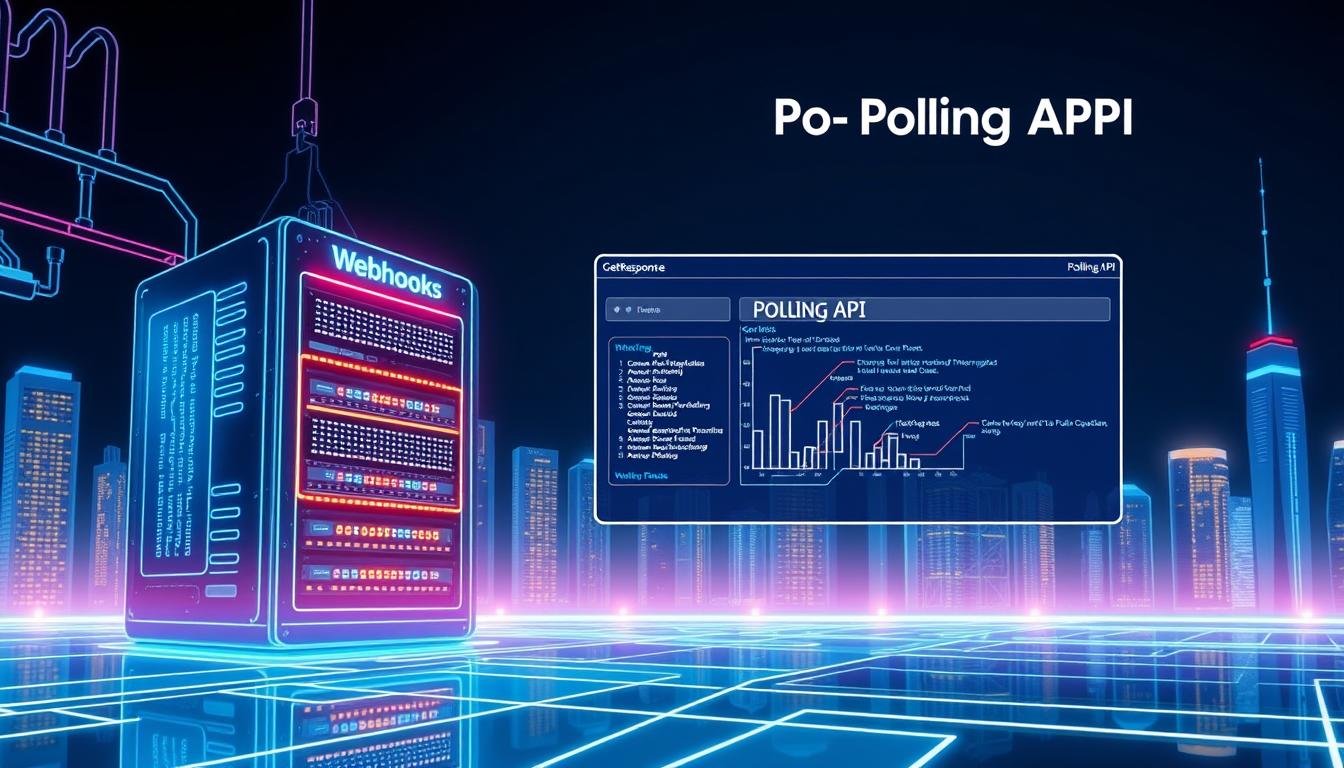Choose the right sync strategy for your product by weighing push-style callbacks against timed requests. You’ll learn how each approach affects data freshness, cost, and reliability so you can match design to business SLAs.
Polling uses recurring GET requests on a schedule. It is easy to implement and gives you control over cadence. At high frequency it becomes inefficient and can strain resources.
Webhooks deliver event payloads from a server to your endpoint in near real time. They reduce needless calls and improve perceived latency. But callbacks are one-way and can fail if either side is down.
We’ll compare how these methods handle bursts, retries, and typical marketing events like contact or payment status changes. You’ll see when a hybrid model—push for primary delivery, timed requests as a backstop—best serves resilience.
Key Takeaways
- Push vs pull: Push is efficient; pull is predictable.
- Freshness: Callbacks give near real-time updates; scheduled checks lag.
- Reliability: Combine methods to guard against outages.
- Cost: High-frequency pulls can waste bandwidth and compute.
- Design tip: Plan security and observability from day one.
Overview: Real-time updates in modern applications
Modern applications demand timely information so users see the current state of accounts, orders, and messages.
Why timely data matters for user experience
Timely updates directly affect trust and conversion. When dashboards and notifications lag, users notice.
Fast feedback increases retention and reduces support tickets. Payment alerts, session changes, and notifications often need seconds, not minutes.
APIs as the bridge between servers and clients
APIs connect back-end systems and partner services to your client-facing experiences. They move data and events from one server to another so your application shows current information.
Two broad delivery patterns exist: one checks for changes on a schedule; the other pushes events as they happen. Each has trade-offs in latency, cost, and complexity.
- Design for variability: network time and service availability shape how fresh data feels.
- Document your schema: consistent formats help applications consume updates predictably.
- Match SLAs to use case: some services need seconds; catalog syncs can accept minutes.
Ultimately, align your approach with user expectations, system limits, and the capabilities of the services you depend on.
How webhooks work in GetResponse-style integrations
In event-driven integrations, providers push changes to your system the moment something happens. This model flips the usual check-and-wait pattern: the external server sends data to you, not the other way around.
Event-driven delivery
When an event occurs, the provider issues an HTTP POST with a JSON body to your webhook endpoint. You parse the payload, validate the signature, and return 200 OK to confirm delivery.
Endpoint, payload, and verification
Expose a secure endpoint that accepts POST requests. Verify signatures and use HTTPS for authentication and integrity. Make handlers idempotent so your application copes with retries and duplicate requests.
- Near-instant updates: fewer unnecessary requests and faster delivery of changes.
- Custom filters: receive only the events you care about, cutting cost and noise.
- Efficiency: reduces load on both your servers and the provider.
Limitations
If your service or the sender’s servers are down, notifications can be delayed or lost. Webhooks are one-way by design, so follow-up actions still need separate calls.
How polling works when consuming GetResponse data
A time-driven approach repeatedly queries endpoints to surface changes on a predictable schedule.
How it operates: Your system issues scheduled GET requests to the provider endpoint. Each call asks for the latest data, then you compare results and apply any new changes.
Practical advantages: It is simple to implement and widely available wherever an api exists. You control the cadence, tuning intervals from every minute to once a day to match your needs.
- Scheduled GETs retrieve updates on a fixed cadence you set for your application and clients.
- It’s dependable when push delivery isn’t supported by external systems.
- Tune intervals to balance freshness and cost—short for hot paths, long for archives.
Common drawbacks: Polling is not true real time. Most calls return unchanged results, which wastes bandwidth and server resources.
To reduce inefficiency, use incremental parameters (since, updated_after), ETags, and robust backoff and retry logic to handle transient network issues.
getresponse webhooks vs polling api: key differences at a glance

Latency, cost, and failure modes define the differences between push-style delivery and repeated fetching.
Latency and freshness of updates
Webhooks deliver near-real-time notifications for critical events. That makes them ideal when seconds matter.
Polling adds delay equal to your interval. Short intervals cut latency but raise load and complexity.
Resource utilization and rate limits
Polling often creates many requests and redundant calls, which can waste bandwidth and hit provider limits.
Push reduces needless traffic and conserves compute resources, but it shifts cost to uptime and observability.
Implementation complexity and infrastructure needs
Push requires public endpoints, signature checks, retries, and monitoring. Polling needs schedulers and incremental fetch logic.
Failure modes, retries, and missed events
Push can lose events without retries; polling can miss intermediate states between intervals. Both benefit from idempotent handlers and clear schemas.
| Aspect | Push-style delivery | Scheduled fetching |
|---|---|---|
| Latency | Low — near real-time | Variable — equals interval |
| Resource use | Efficient on requests, needs endpoint capacity | High request volume, predictable batch load |
| Failure mode | Missed events without retry | Stale information between polls |
| Best fit | Important, sparse events | Frequent changes or no push support |
- Rule of thumb: use push for time-sensitive events and polling for dense, high-change applications.
- Document SLAs, backoff strategies, and idempotency to keep your system resilient.
When to use webhooks, when to use polling
Pick the right delivery path by matching how often data changes to how fast your clients must see it.
Use webhooks for low-frequency but time-sensitive events
Use webhooks when a missed or delayed notice harms the user experience or revenue. Examples include payment notifications, unsubscribe actions, or compliance alerts.
Why: these events are rare but critical. Push delivery minimizes latency and keeps your application state consistent in seconds.
Use polling for frequent updates or when webhooks aren’t supported
Use polling when updates are high-volume or the provider does not offer push delivery. Ticketing systems or busy product feeds often generate thousands of changes per hour.
Polling gives you predictable load and a clear window for state reconciliation.
- Choose webhooks for instant awareness of events that affect experience or revenue.
- Rely on polling when bursts could overwhelm your receiver or when push is unavailable.
- For product catalogs, schedule periodic checks if second-level freshness isn’t required.
- Document decision logic: event criticality, expected frequency, and latency tolerance.
- Align client SLAs and test at scale to validate throughput and backoff.
Designing a hybrid approach for robust delivery

A hybrid delivery model blends immediate push notifications with scheduled checks to cover gaps and guarantee consistency. Use push for speed, then reconcile with timed fetches when messages are missed.
Primary webhooks with polling as a fallback
Lead with webhooks for immediacy and low latency. Configure a defined backfill window where your system will use polling to recover any missed events.
Why this works: push reduces needless requests in steady state. Fallback polling closes gaps when connectivity or configuration issues occur.
De-duplication, idempotency keys, and backfill windows
Keep a durable event log with unique IDs or idempotency keys so retries never create duplicates in your system of record.
Poll incrementally (for example, since the last processed timestamp) to keep payloads small and avoid reprocessing unchanged data. Design your endpoint so replayed events are safe. Your code should tolerate out-of-order delivery and duplicates.
- Track delivery attempts and failure reasons to diagnose network and configuration issues fast.
- Calibrate fallback polling intervals to balance load and recovery time for new data.
- Maintain runbooks so engineers can adjust backoff, replay queues, or polling frequency during incidents.
- Validate the hybrid path in staging with chaos scenarios like dropped requests and slow receivers.
| Capability | Primary (push) | Fallback (timed checks) |
|---|---|---|
| Latency | Near real-time | Variable — depends on interval |
| Duplication handling | Idempotency keys required | Incremental fetch + dedupe |
| Recovery | Retry and replay | Backfill window to reconcile state |
| Operational needs | Endpoint capacity, monitoring | Scheduler, incremental queries |
Security and reliability essentials
Strong authentication and robust retry strategies keep your event stream consistent even under failure. Design your defenses so they stop attackers and make normal failures visible and recoverable.
HTTPS everywhere and signature validation
Enforce HTTPS end to end and verify signatures on every inbound notification. That prevents spoofing and protects sensitive information in transit.
Authentication strategies for polling and callbacks
Apply least-privilege authentication for both timed requests and push callbacks. Rotate keys and secrets regularly. Limit client scopes so a leaked credential cannot expose the whole system.
Retries, backoff, and dead-letter handling
Use exponential backoff with a capped retry count. Route poison messages to a dead-letter queue for manual review. This keeps your main queue healthy and your data consistent.
Rate limits, timeouts, and circuit breakers
Define rate limits for polling to protect provider and your own server capacity. Set sensible timeouts and use circuit breakers so a slow upstream doesn’t cascade into broader issues.
- Log every request with correlation IDs to trace flows across services.
- Document security expectations in your developer portal so integrations work right the first time.
- Audit endpoints and run chaos tests to verify resilience under real-world failure scenarios.
Performance and cost considerations
Balancing frequency and capacity is the core of any efficient event delivery strategy. Tune cadence and queueing to keep costs predictable while preserving timely updates for your users.
Controlling polling intervals to manage API and server load
Right-size your polling intervals to protect provider rate limits and reduce needless requests. Short intervals improve freshness but raise cost and load on your servers.
Tip: implement adaptive intervals that slow during quiet periods and speed up when change rates rise.
Webhook throughput, queuing, and burst handling
Design receivers with buffering and durable queues so spikes don’t drop events. Smooth bursts into workers and scale horizontally to keep steady throughput.
Use lightweight payloads and compression where supported to lower bandwidth and speed processing.
Monitoring delivery latency, error rates, and resource usage
Measure end-to-end latency, error rates, and per-event cost. Track trends so you catch regressions before they cause silent data drift.
- Establish SLOs for update timeliness and error budgets.
- Alert on rising error rates or queue growth.
- Track cost per call and per processed event to guide your approach.
Implementation pointers for developers
Design decisions around transport, schema, and logging determine how resilient your integration will be in production. Start with clear rules for how your endpoint accepts payloads and how clients authenticate.
Structuring endpoints, events, and payload schemas
Register a URL that accepts POST payloads and returns 200 OK on success. For periodic fetches, implement GETs with incremental parameters like updated_since and use pagination to keep responses small.
Define consistent, versioned schemas so your product can evolve without breaking clients. Include an event ID and an idempotency key to avoid duplicate processing.
Validation, logging, and observability for troubleshooting
Validate JSON payloads and signatures before business logic runs. Reject malformed requests with clear error codes and log both successes and failures.
Keep code that handles transport (HTTP parsing, retries, timeouts) separate from business code. Instrument traces and structured logs to measure latency and error rates.
- Provide example requests and SDK snippets to speed onboarding.
- Use dedupe via event IDs and store a durable delivery log for replay.
- Document on-call playbooks, rollback steps, and temporary interval changes during incidents.
| Area | Action | Benefit |
|---|---|---|
| Endpoint | POST/200 OK, register URL | Reliable delivery |
| Polling | GET with updated_since | Efficient backfill |
| Observability | Traces & logs | Faster debugging |
Conclusion
Balance immediacy and predictability when deciding how your system receives new data. For immediate, high-impact notifications, webhooks deliver real-time updates the moment an event occurs. They cut latency and reduce unnecessary requests but demand endpoint security and monitoring.
For frequent synchronization or simpler setups, polling gives predictable load and straightforward recovery using intervals and incremental fetches. It suits high-change product feeds where slight delays are acceptable.
A hybrid approach often wins: favor push for speed and use periodic pulls to backfill missed changes. Bake in HTTPS, signature checks, retries, and observability so your product protects users and recovers fast.
The right choice improves user satisfaction, lowers support overhead, and keeps information accurate across your web applications and systems.

